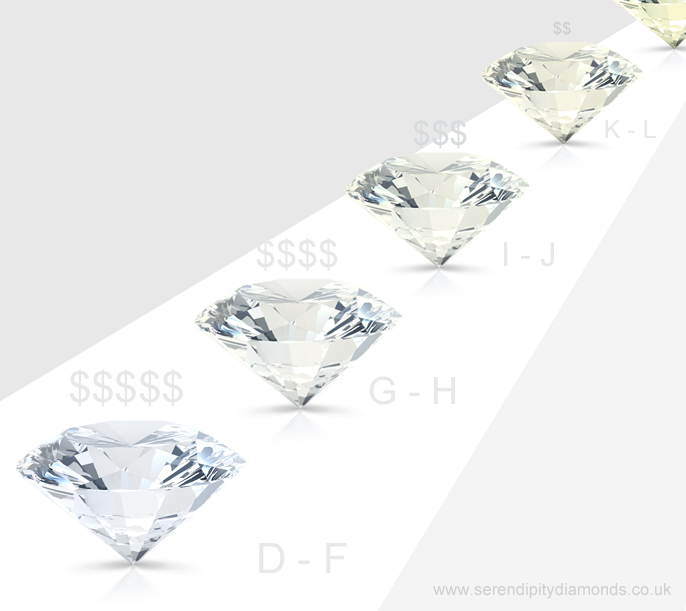How does diamond colour affect the true value of a diamond ring?
Alongside other factors, colour affects the value of any diamond.
Diamonds fall into several different categories of colour. Ranked in order of value, diamonds exist in a variety of colour types.
Firstly, natural fancy diamonds (highest value)
Next, colourless or near-colourless diamonds vary in subtle shades of whiteness.
Finally, Tinted colour diamonds (yellow/brown)
Natural fancy-coloured diamonds
Diamonds graded as naturally fancy in colour demand the highest prices of all diamonds. Colours include fancy pinks, reds, yellows, blues, greens, greys and black. Natural fancy colours occur in nature. Variations of chemicals, or the diamond’s structure, cause colour variations.
The term fancy diamond often describes shapes other than round. In contrast, fancy colour describes a visible colour other than white.
Natural fancy diamonds sell to collectors. Furthermore, their value increases owing to their exceptional rarity in nature.
The value of such diamonds increases with intensity. For example, natural fancy intense Pink diamonds demand incredible prices. Furthermore, many are sold privately at auction.
The value of pink diamonds for investors over time
The following chart shows the increase in the value of a pink diamond over time. Most natural diamonds of this colour originate from Australia’s Argyle diamond mine.
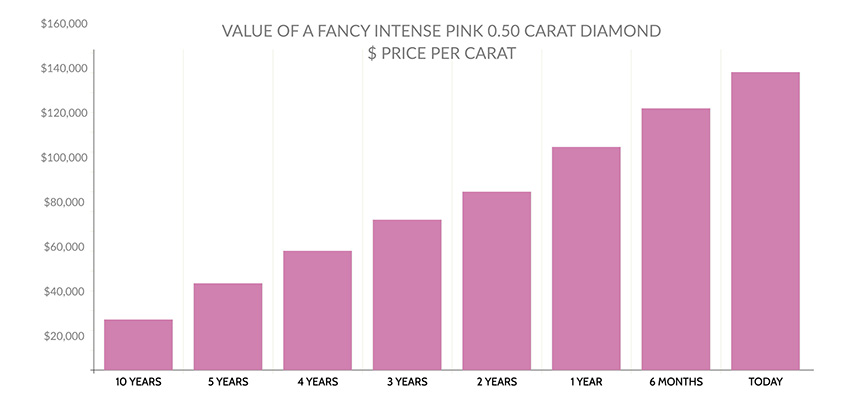
Colourless Diamonds
Colourless and near-colourless diamonds demand high prices. Especially when it comes to larger diamonds in high-clarity grades. A perfect diamond, with an excellent cut, polish and symmetry, adds further to the value.
White diamonds are assigned a colour based on a grading scale. This colour scale runs from D to Z. The very best colour achieves a D grade. Two close colours can be very hard to distinguish to an untrained eye.
 Most high-value engagement rings feature colourless or near colourless diamonds. However, lower colour-grade diamonds make up a large proportion of rings sold.
Most high-value engagement rings feature colourless or near colourless diamonds. However, lower colour-grade diamonds make up a large proportion of rings sold.
Why are there no A, B or C grades?
But, Why does the grading system start with D?
Before adopting the GIA diamond grading system for colour, other grading systems existed.
Some laboratories used letters A, B and C without any clear and concise relation to specific colours. Some systems even used an AA grading for diamond colour.
Other traditional terms, such as Wesselton and Top Wesselton, represented multiple grades of whiteness and were easily confused.
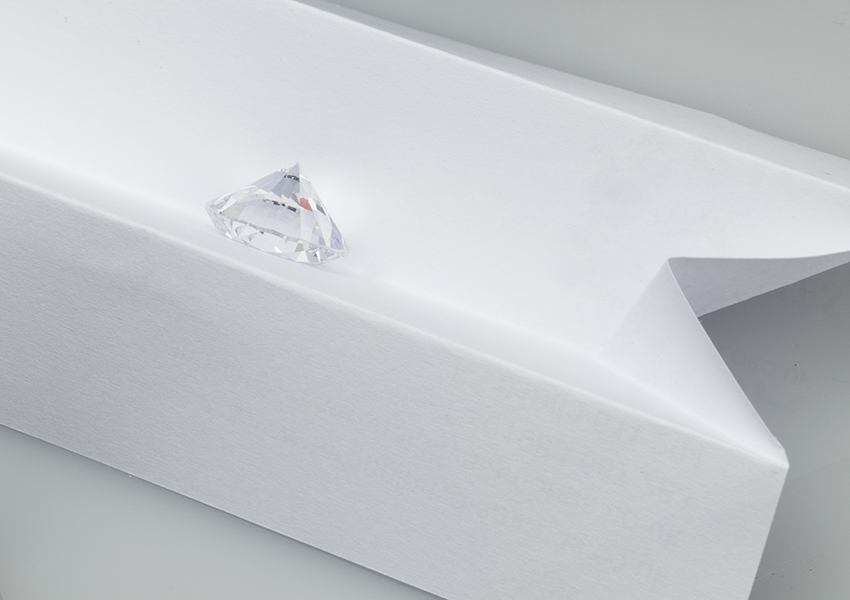 Starting afresh, GIA opted for symbols that were unused in any current system at the time. For this reason, they created a colour scale for diamond whiteness, starting with the letter D.
Starting afresh, GIA opted for symbols that were unused in any current system at the time. For this reason, they created a colour scale for diamond whiteness, starting with the letter D.
To this day, the GIA grading scale used Worldwide grades diamonds from D – Z. Further down the scale, diamonds become less white. Beyond ‘J’ colour, a tint of yellow or brown becomes visible. Mr. Liddicoat of the GIA determined colour by combining tone and saturation. Both factors combine to give depth of colour. (GIA – Gemological Institute of America.)
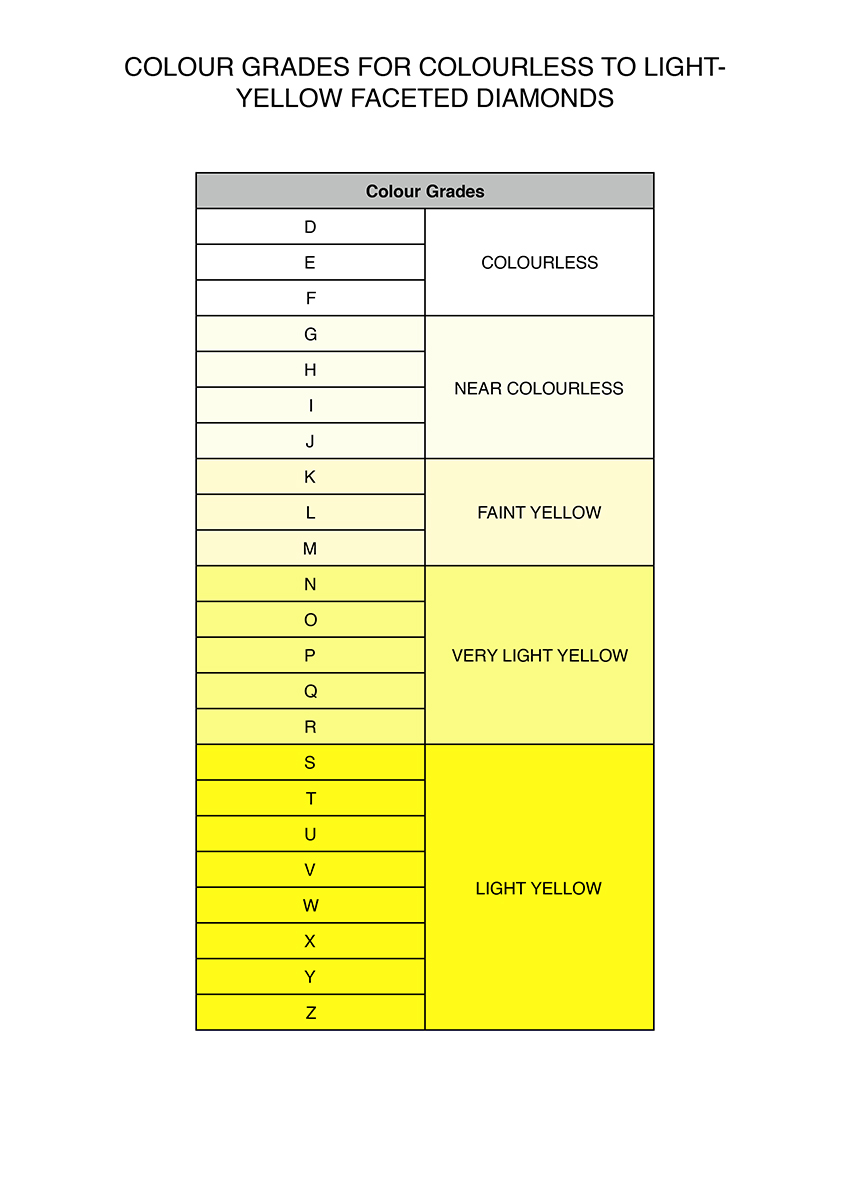
Interesting Facts about Diamond Colour
- It is possible to be colour-blind and still successfully grade diamond whiteness.
- Diamonds are graded under constant white light produced by daylight tubes
- Diamonds are graded within a neutral, plain background to avoid surrounding colours interfering
- Natural blue fluorescence can improve the appearance of colour in tinted diamonds
- “Master” sets of diamonds are generally used to compare the diamond colour with the stone being graded
- G to I colour diamonds are exceedingly hard to distinguish for colour when set into a ring
Whiteness and the value of a diamond
When most people think of a diamond, they rarely consider the many variations in colour.
Most people understand that fancy-coloured diamonds exist. But, they rarely understand the effect of whiteness on diamond value.
Two diamonds of the same carat weight, cut, and clarity differ significantly in value owing to a difference in whiteness.
Fewer diamonds exist in higher colour grades. For this reason, white diamonds are rare. Moreover, D-colour diamonds are very rare. Especially as very big diamonds.
The nearer to colourless the diamond is, the rarer and more valuable the stone will be. Paired with a Flawless or Internally Flawless clarity grade, the price soars.
Tinted white diamonds
Look at any diamond colour chart. Below white colour grades, the term tinted describes a reduction in whiteness. Typically a yellow tinge. This colour intensifies as we move down the colour scale.
Black, Brown, Champagne Diamonds and Cognac Diamonds
Brown diamonds
Some strong colours, such as black and brown diamonds, rarely demand high prices. For this reason, they offer great value. Surrounded by white diamonds, they make eye-catching jewellery. Some companies describe brown diamonds as Chocolate diamonds. Look online and see many jewellers offering a chocolate diamond ring.
In recent years, we created many items with brown diamonds. We usually source high-quality brown diamonds. In detail, VS clarity brown diamonds. In addition, we choose the closest colour to a rich chocolate shade, as you see below.

Black Diamonds
Black diamonds lack any transparency, unlike Brown diamonds. They make a unique choice. More affordable than white diamonds, black diamonds suit halo settings. Encircled by white diamonds, Black diamonds add contrast to jewellery.

Champagne Diamonds
This attracts many luxury buyers. In a similar way, many low-colour, yellow-tinted diamonds sell. Over the years, I have seen many such diamonds described as Champagne diamonds or Cognac diamonds for their colour. Some of these colours have a fancy light appearance.
Canary Yellow Diamonds
Lovely expressions exist for some colours. I love the description of Canary Yellow for diamonds. Canary yellow diamonds give an intense burst of lemon yellow. Furthermore, they look amazing, set into a halo of white diamonds. A less expensive alternative includes Yellow Sapphires.

Fancy-coloured small diamonds
Many natural fancy coloured diamonds exist in small sizes. Tiny diamonds and pavé set into a band look incredible. I have seen pink diamonds set in this way in Platinum. Similarly, we create pavé set wedding rings with alternating rows of black and white diamonds.
A note on colour intensity and visibility of colour in diamonds
Over the years, I have seen many certified pink diamonds with such a pale hint of pink. As a result, once set, the colour remains unseen.
In a similar way, some lightly tinted brown diamonds look much whiter, set into rings. In fact, brown and pink diamonds have many similarities besides value.
Their colour comes from the same physical lamellae in the crystal. A pink diamond can lose its intensity of colour when cut in a certain way. For this reason, we rarely see natural pink diamonds in round shapes.
Pink diamonds come from the Argyle mine in Australia. The same mine produces most of the World’s brown diamonds. Many of the pinks sell at private auctions. Many sell before they even reach circulation between dealers.
Alternative gemstones to fancy coloured diamonds
Based on experience, few buyers realise the cost of a natural fancy colour diamond. In fact, many enquiries vanish when we quote the price of a natural pink diamond. As a result, we create many designs with precious gemstones.
In addition, we now provide lab-grown diamonds in a variety of colours. Diamonds gown and treated at high-pressure-high temperatures include different colours. For example, blue and pink. The following video includes examples of some of our coloured lab-grown diamonds, available at prices far below natural diamonds.
Gemstones can give a similar look to a coloured diamond. For example, our most popular request is for pink Sapphires. Our Tickled Pink engagement ring remains one of our best-selling rings.
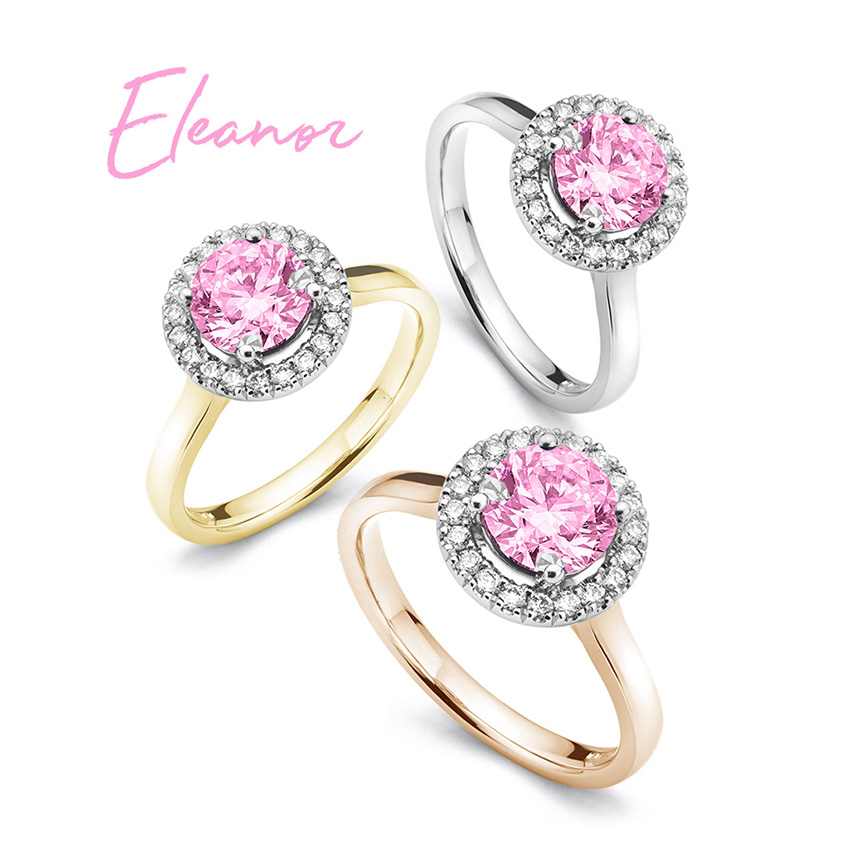
Eleanor halo ring shown with a Pink Sapphire centre stone
Other alternatives include Aquamarines instead of pale blue diamonds. Or, Cornflower pale blue Sapphires. Owing to their similar hardness, Sapphires make a great alternative gemstone.
Decide firstly your preferred colour. Then, decide how much you have to spend on the stone or the completed item of jewellery. This usually gives the jeweller a good idea of the best gemstone.
About Mark Johnson
My name is Mark and I'm founder at Serendipity Diamonds. I have 30 years or experience in polished diamonds and jewellery. Today, I work with an expert team in our Isle of Wight jewellery showroom located in Ryde. Most of my work involves helping clients in our showroom, working on our two websites and photographing jewellery commissions.



